
What do the handsomest man of all time, the goddess of grain, and the god of wine have in common? At first glance it might appear that these are unrelated topics, but in fact all of these Greek myths have the same underlying theme: the mystery of life and death, with characters that all relate to fertilty beliefs based on the natural cycle of plant life.
This theme is found not only in the Greek world; it is an important element of the early Near Eastern religions, with which the Greeks were familiar. In the section on Artemis is one example of the fusion of the Greek goddess with Near Eastern imagery, known as Artemis of Ephesus.
The different myths from many cultures feature a goddess and a story of return from death: in Egypt there was the myth of Isis and Osiris, in Phrygia it was Cybele and Attis, in Sumer the goddess Inanna and Dumuzi.
The theme appears in the three Greek myths described below.
Contents
We have previously discussed Aphrodite/Venus in Section 4, but there is one more important myth involving her, told here because of the theme of the goddess and a return from death. First the unusual story of the birth of Adonis.
Cinyras, ruler of Paphos on Cyprus (and a direct descendant of the sculptor Pygmalion, whose statue came to life), had a daughter named Myrrha. Because she neglected the proper worship of Aphrodite, the goddess punished Myrrha by causing an insatiable lust for her father Cinyras. Knowing that he would never approve of incest, she deceived him by disguising herself as someone else, but after he learned of the deception he was so enraged he pursued his daughter intending to execute her. She prayed to the gods for some escape, and she was transformed into the myrrh tree (from her name Myrrha).

Poussin
Despite her transformation, Myrrha produced a son, named Adonis, who grew up to become the handsomest man of all time. Here we see the scene of his unusual birth in a pen drawing by Nicolas Poussin (1594-1665). Note the presence of Aphrodite and her attendants, the three Graces.

Pen Drawing by Poussin
After he matured, Adonis became one of the very few mortal men with whom Aphrodite had an affair. When he was not with her, Adonis was a renowned hunter, often identified in artwork by his hunting dogs, as seen below in the painting by Anibale Carracci (1560-1609), dated to 1590 (early Baroque).

Venus, Adonis, and Cupid, Carracci (c. 1595)
The next painting, by Paolo Veronese (1528-1588), shows Adonis resting in the lap of the goddess. This is in fact an ironic pose, for soon after this, he will be in her lap as he is dying.

Aphrodite and Adonis, Veronese (c. 1580)
The painting by Titian shows Adonis leaving to go out on the hunt once again, but Aphrodite is pleading with him, for she has had a premonition of danger. She warns him not to pursue any creature that may turn against him. Despite her warning, he is indeed fatally wounded when a wild boar charges him. Some say this boar was Ares in disguise, jealous of Adonis' relationship with Aphrodite.

Venus and Adonis, Titian (c. 1554)
The Etruscan box seen below is actually a cremation container.

Etruscan Box
The final painting is by 20th Century American artist Bryson Burroughs, with the corpse of Adonis being carried off. But Aphrodite refused to let him die altogether. One version says that his blood transformed into an ever-blooming flower, the red anemone. Another says that Aphrodite made an arrangement to share Adonis with Persephone, goddess of the Underworld (see the next story for more on her), after which he spent four months with Persephone in the Underworld, four months on the surface with Aphrodite, and was free to choose where to spend the remaining four months.

Burroughs
The principal ancient source for this story is the Homeric Hymn to Demeter, which begins with the first scene below, the abduction of Persephone, daughter of Zeus and Demeter (Ceres), the goddess of grain and agriculture, by Hades, god of the Underworld.
The first version below is by Bryson Burroughs (just mentioned above), while the second version is by the most famous Dutch artist of the 1600s, Rembrandt. Hades is simply powerful enough to take her by force, knowing well that no woman would willingly become his bride in the gloomy Underworld.

Burroughs
One of the greatest depictions of this scene is this work of the Baroque sculptor Gianlorenzo Bernini, seen below in several different views.
After losing her daughter, Persephone's mother, Demeter, searched fruitlessly for her, eventually settling in the city of Eleusis (near Athens), a city that became forever sacred to her. But while her daughter was in the Underworld (synonymous with being dead), Demeter refused to let crops grow, and Zeus had to intervene to save humanity. Hermes was sent to Hades to deliver Zeus' order that Persephone be allowed to return to her mother. But before departing, Hades asked her to eat some pomegranate, as seen in the painting below by Rossetti.

Rossetti
The final painting, by 19th Century artist Frederick Leighton, shows Hermes returning Persephone to the land of the living, to be reunited with the joyous Demeter. But Persephone then learns that because she ate the pomegranate, she is eternally linked to Hades and will have to spend a few months with him in the Underworld each year.

Leighton
This story is thus not only a story of returning from death, it is also clearly an allegory which explains the seasons: winter is the time when Persephone is with Hades, and Demeter allows nothing to grow, but in the spring Persephone returns, just as the new plants bloom.
This sculpture, dated to 1621-22, is now on display at the Borghese Gallery, Rome.

Bernini
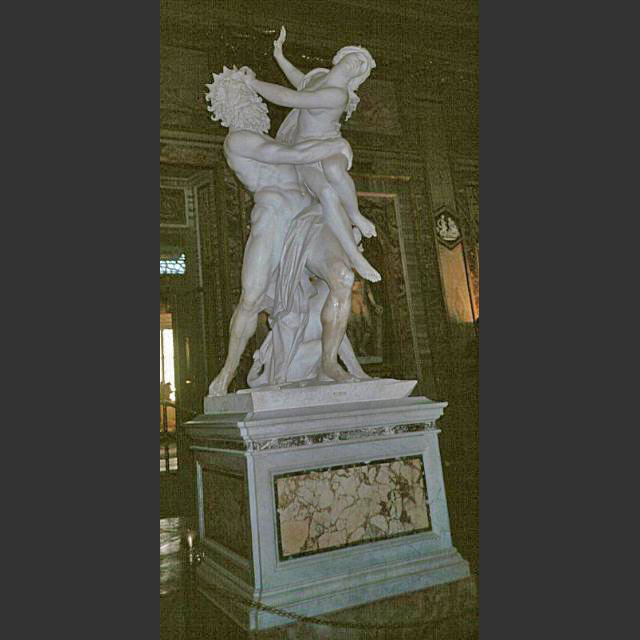
Bernini 2

Bernini 3
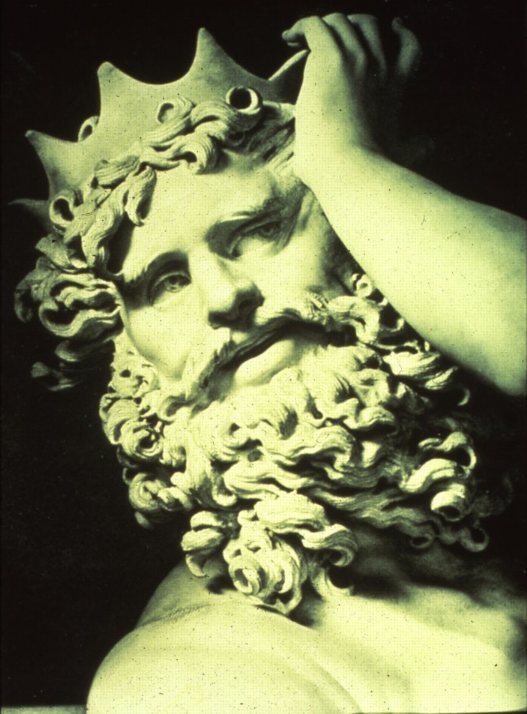
Bernini 4

Bernini 5
Although frequently given the simple definition "the god of wine", Dionysus (or Bacchus) was originally another form of fertility deity, a god associated with the natural cycle of life and death of plants. Over time, this became combined with one particular plant, the grape, used to make wine, and its effects of intoxication.
The first image below shows a radically unusual painting by Gustave Moreau inspired by the birth of Dionysus, but much of the symbolism is difficult to recognize. The ancient myth says that Zeus mated with a mortal woman named Semele, who unwittingly begged Zeus to reveal his true form, which utterly incinerated her. Here Zeus resembles Apollo, with the suffering Semele in his lap, while their offspring Dionysus, winged and goat-legged, flies away, covering his face.

Jupiter and Semele, Moreau (1894-95)
The second version by Moreau is a simpler variation, somewhat more accessible.

Jupiter and Semele, Moreau (1889-95)
The next image is a red-figure vase painting depicting the 'second birth' of Dionysus, for Zeus had to put the embryo taken from Semele's corpse and put it in his thigh until ready to be born. Hermes stands nearby ready to take the child to Mt. Nysa, where he will grow up.

Red Figure
The white-ground vase painting by the Phiale Painter (the same artist as the Hermes Psychopompus seen in Section 6) shows Hermes delivering baby Dionysus to a white-bearded figure, presumably the god of Mt. Nysa.

Phiale Painter
The first painting by Poussin also shows Hermes delivering little Dionysus to Mt. Nysa. Note Zeus in the heavens watching, with the intoxicated figures all around. This theme recurs in the second painting by Poussin, showing little Dionysus starting his drinking lifestyle very young.

Poussin 1

Poussin 2
Finally, this odd painting by Guido Reni (1575-1642), with the chubby little god guzzling wine while urinating.

Drinking Bacchus - Reni (1623)
Here we see the fully-grown Dionysus, first in this black-figure vase painting by the Amasis painter (this is the opposite side of a vase seen in Prometheus, showing Athena and Poseidon). The first view shows the overall vase in color.

Amasis Painter
Following is a detailed close-up. Notice Dionysus' elaborate hairstyle and patterned gown, both of which give him a feminine appearance, as well as a Near Eastern ornateness. The two females approaching him with arms linked are some of his followers, the Maenads or Bacchae, whom we will see further below.
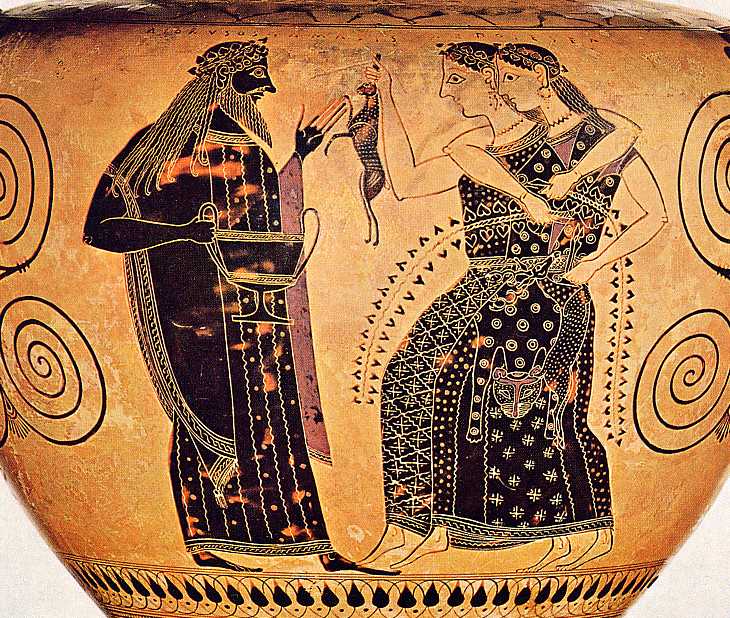
Amasis Detail
This red-figure vase painting is rather simple, a basic, generic depiction of Dionysus. Note his drinking-horn in one hand and his symbolic staff, known as the thyrsus, in the other.
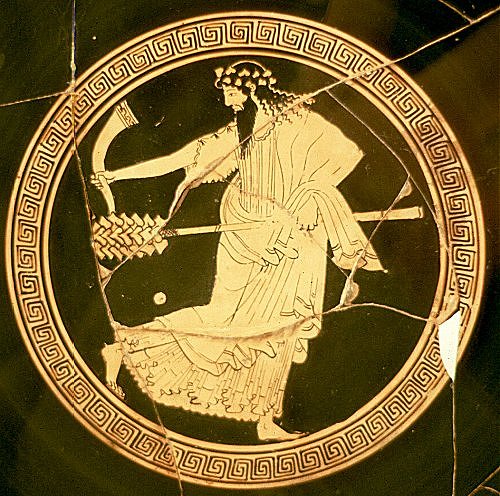
Red Figure
Next are several views of one vase painting by an artist known as the Kleophrades Painter, one of the recognized masters from the Classical period. The first image is an overall view of the vase, the second is a close-up of the main figure of Dionysus, followed by another detail showing one of his Maenad followers.

Kleophrades
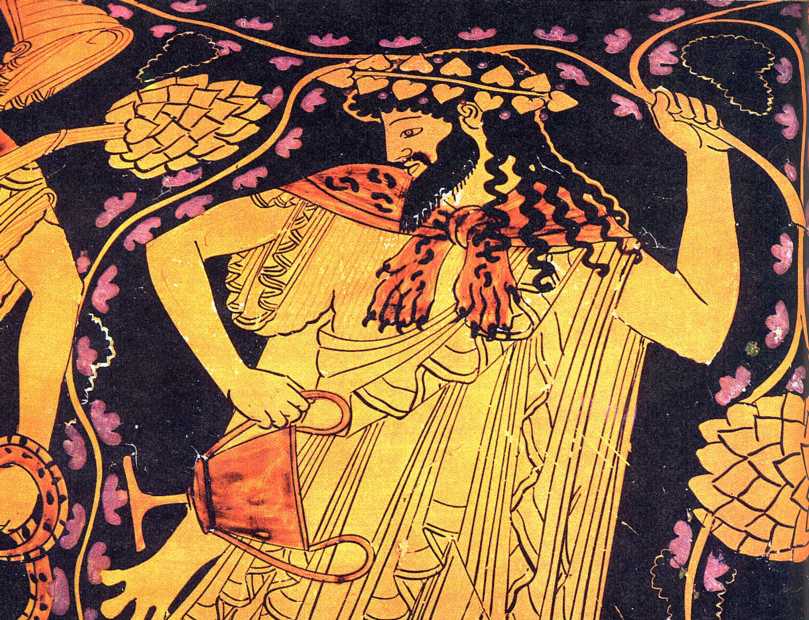
Kleophrades detail
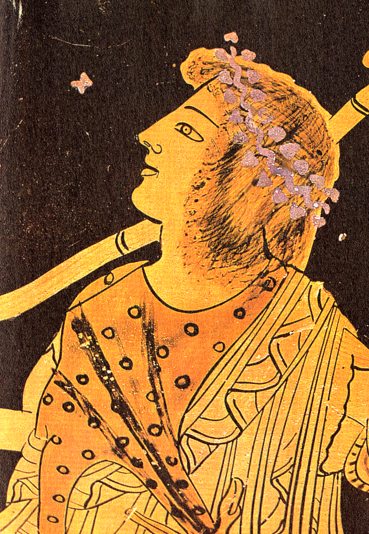
Kleophrades Maenad follower
The last image here is a facsimile drawing showing the entire vase painting flattened out: Dionysus is surrounded by both Maenads and the male satyrs, more of whom are seen below.

Facsimile
The black-figure vase painting below is by the artist Exekias, one of the masters of the Archaic period (several of his works can be seen in the article on the Trojan War). Here he has done a superb job of encapsulating one of the earliest stories of the god, recorded in the Homeric Hymn to Dionysus. This poem tells how a band of greedy pirates kidnapped the young god, assuming he was the son of a wealthy nobleman who would pay a huge ransom for his return. However, once he is captured, Dionysus turns the tables on them and uses his powers to cause strange marvels to occur. He causes grapevines to sprout from the mast of the ship, and transforms himself into a roaring lion. Finally, the pirates leap overboard to escape, only to be transformed into dolphins. Exekias shows the end result, with Dionysus now having the ship all to himself.

Exekias
Next is a wall-painting from Pompeii, where the god is depicted as a living grape-cluster. The peaceful-looking mountain in the background is actually Mt. Vesuvius, which erupted in A.D. 79, burying the city.

Pompeii
Next is the early Renaissance painting by Bellini of the young Dionysus.
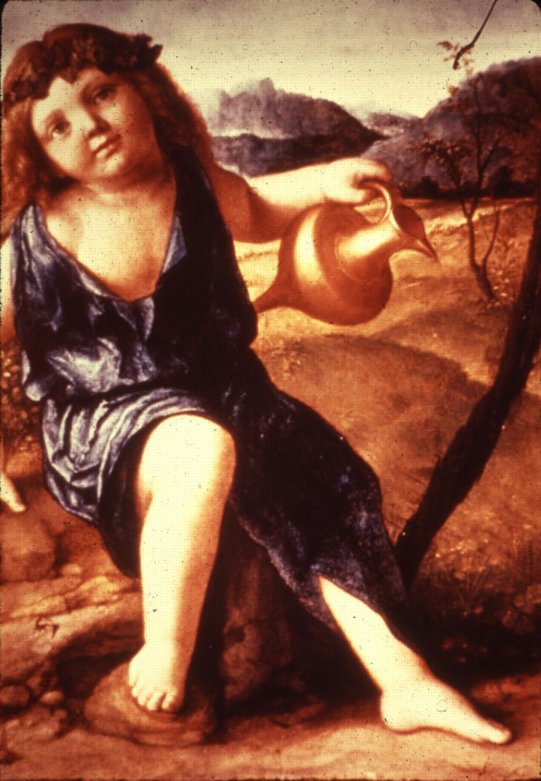
The Infant Bacchus, Bellini (1505-10)
Following are a pair of works by Caravaggio. The first shows him as though a Roman gentleman dressed as the god. The second is known as the "Sick Bacchus," the inevitable result of all that drinking.

"Sick Bacchus" by Caravaggio

Caravaggio
Some artists depict the god as morbidly obese from his lifestyle, as in the painting here by Cornelis De Vos. What is interesting here is the ethnic diversity of his mythical followers.

Cornelis De Vos
Finally another painting by Titian which actually depicts a story covered in the Herakles and Theseus article, when Dionysus finds the princess Ariadne and makes her his bride.

Titian
The Bacchus was one of the earliest major works of this artist. He was only 24 years old in 1496 when he received the commission for this sculptur from a wealthy merchant named Jacopo Galli. Clearly inspired by Classical Greek sculpture, the work is not quite the idealized anatomy of the Greek works. This god is somewhat flabby, and clearly off-balance from the effects of his wine. The statue is seen here from four angles.

Michelangelo 1
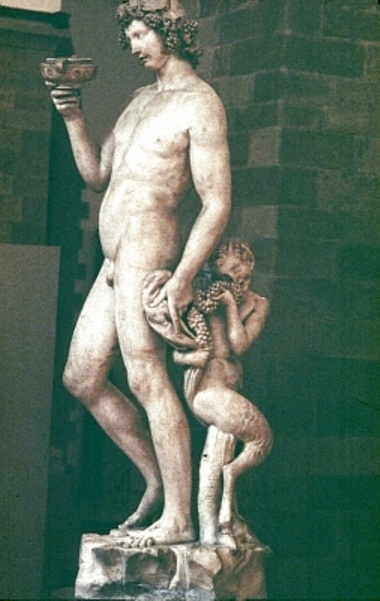
Michelangelo 2
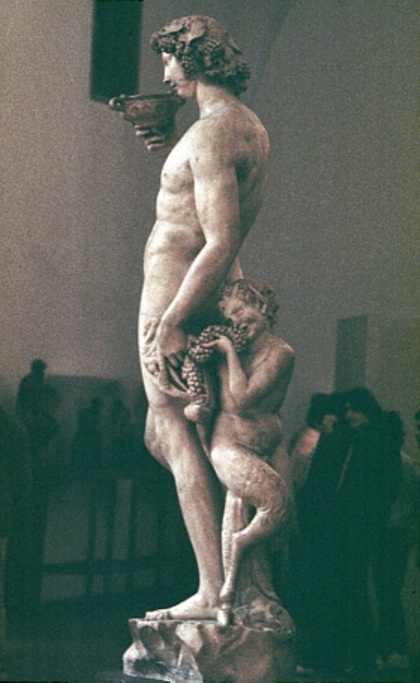
Michelangelo 3

Michelangelo 4
The final image shows the little Pan or satyr at his side, snitching some of his grapes, while the god is too drunk to even notice. It is now on display at the Bargello Museum of Florence.
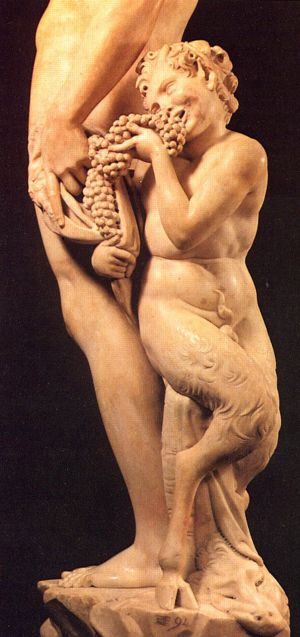
Michelangelo 5
The final group of images spotlights the followers of Dionysus, primarily the satyrs and Maenads. The fist image is a Roman copy of a Classical Greek sculpture of Silenus holding baby Dionysus. The name Silenus is sometimes used for an individual, as seen here, or sometimes in the plural (Sileni), a type of creature basically the same as a satyr.
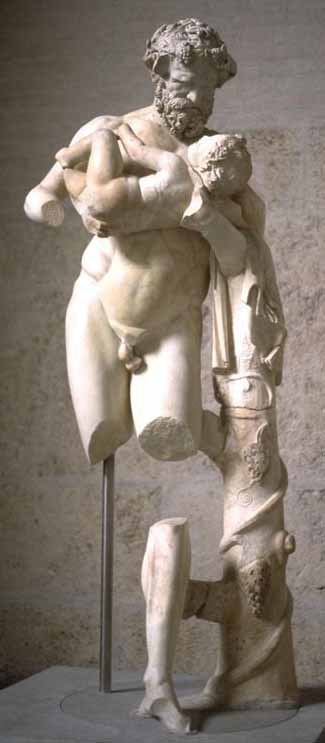
Silenus
Satyrs are often recognized by their shaggy hair and beards, and often a horse's tail (although some artists depict satyrs with goat legs like the god Pan). The second image here is a black-figure vase painting showing several satyrs making wine while Dionysus watches.

Satyrs
The next red-figure painting shows Dionysus reaching for a wineskin, while a satyr to the right plays the flute, with two Maenads on either side.

Dionysus & Followers
The next red-figure painting shows the lustful satyrs pursuing the Maenads, who appear to be fighting them off with their thyrsus.

Satyrs & Maenads
Another red figure vase features a group of raving maenads.

Raving Maenadss
The same theme in the above painting is repeated here with a single pair of a satyr and a Maenad. She appears to be using her sacred staff as a defensive weapon.

Saytyr/Maenad
Next is a red-figure vase showing some satyrs enjoying wine, their favorite activity, in various poses.

Saytyrs
Then is a finely detailed white-ground vase painting of a Maenad, seen first in an overall view, and then in a close-up.

Maenad

Detail
The last two paintings are Victorian paintings, the first by John Collier (1850-1934), circa 1890.
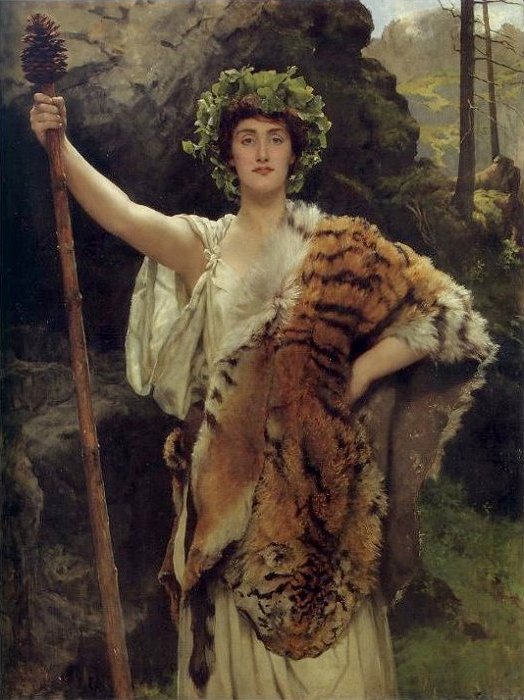
"The Priestess of Bacchus" - Collier
The second is another recreation scene by the artist Lawrence Alma-Tadema (1836-1912). This is the "morning after" the women have participated in one of Dionysus' wild and frenzied celebrations.

"The Women of Amphissa." - Alma-Tadema